Compact triple - Band mimo antenna with high isolation for handheld application
A multiband MIMO antenna design for broadband mobile's applications is proposed in this paper. Based on
PIFA structure, the proposed MIMO antenna is compact in size and designed on FR4 substrate with total
dimension of 37 x 43.6 x 6 mm3. At first, a single PIFA antenna is presented using U-shaped slots in radiating
patch which puts forward the antenna resonant in three frequencies: 2.4 GHz, 3.5 GHz and 6.3 GHz with
bandwidth of 8.9%, 18.3% and 3% respectively for Wi-Fi, Wimax/LTE and Direct Broadcast Satellite DBS of C
channel applications. Good reflection coefficient, antenna gain, and radiation pattern characteristics are obtained
in the frequency band of interest. Secondly, the paper has put forward another single type of tri-band PIFA
which uses double rectangular shape of Defected Ground Structure (DGS) technology. This helps increasing the
antenna efficiency at all frequencies as well as enhancing antenna gain of the PIFA. Finally, a MIMO PIFA
antenna is constructed by placing two single antennas side by side at close distance of 4 mm. The MIMO
antenna also gets high gain and radiation efficiency at all frequencies. To reduce the mutual coupling between
antenna elements, a combination of two “slot and variation” structures of DGS is proposed. Moreover, these
DGS structures have enhanced MIMO antenna bandwidth at all three bands, especially at 3.5 GHz resonant
frequency.
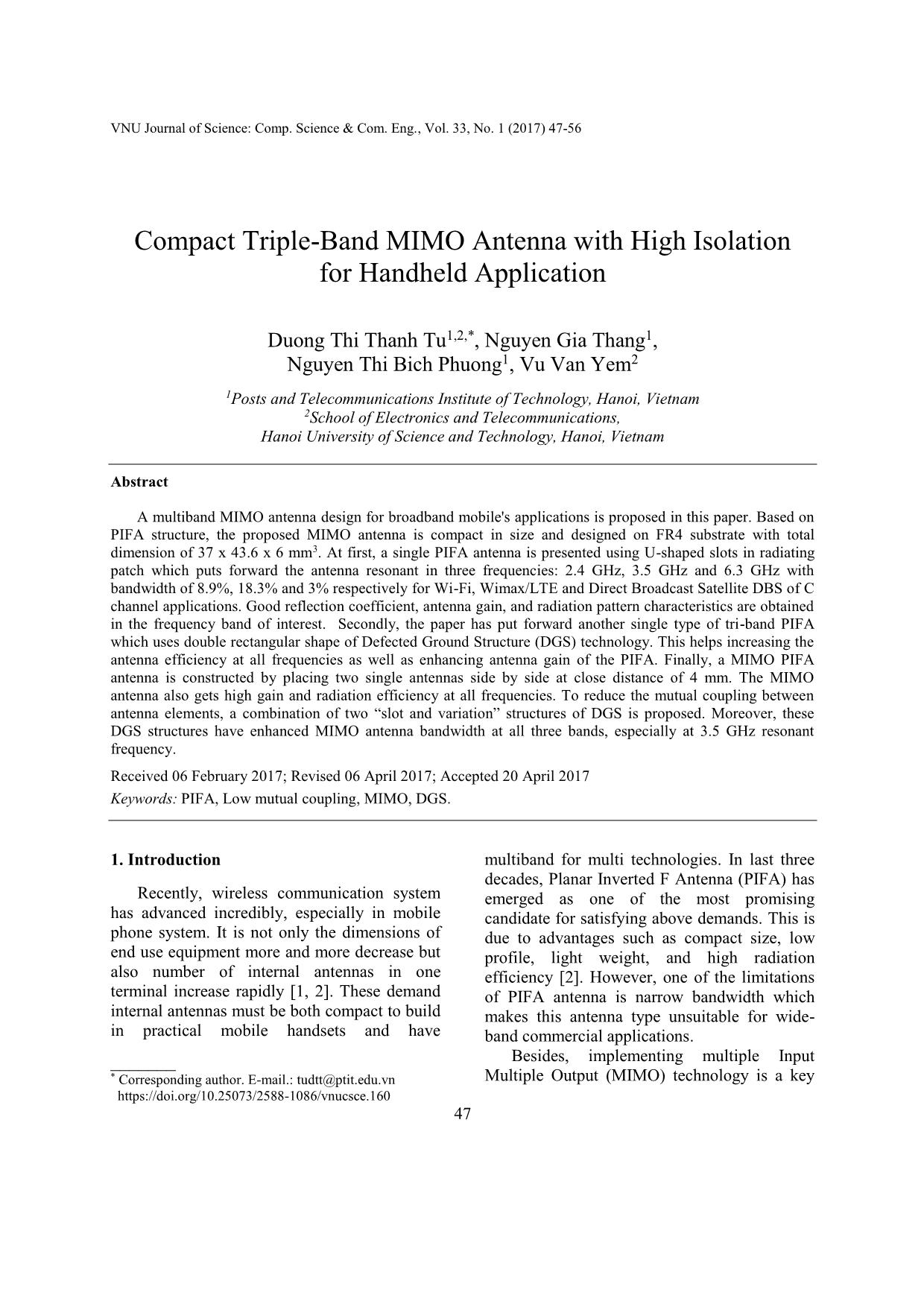
Trang 1
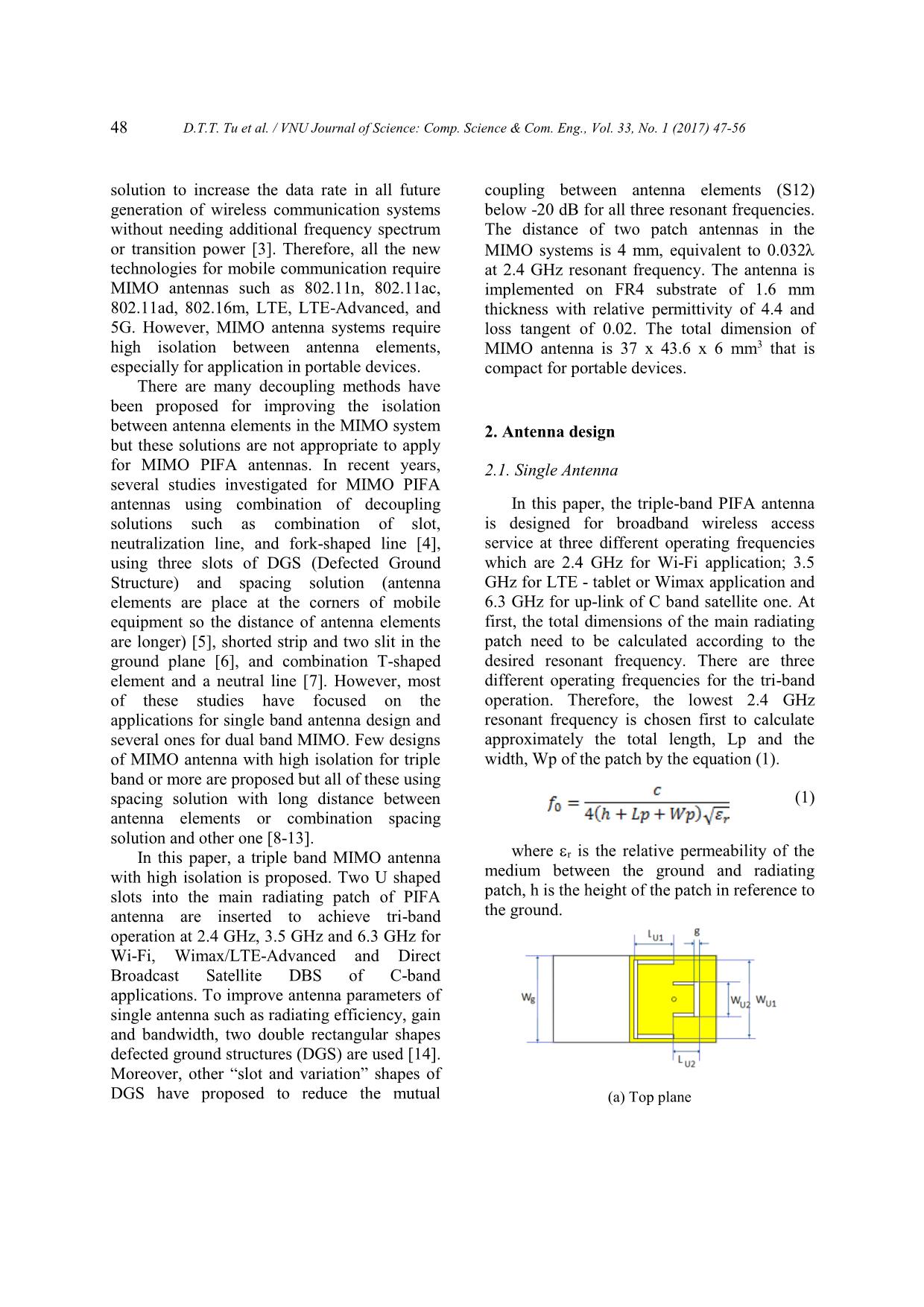
Trang 2
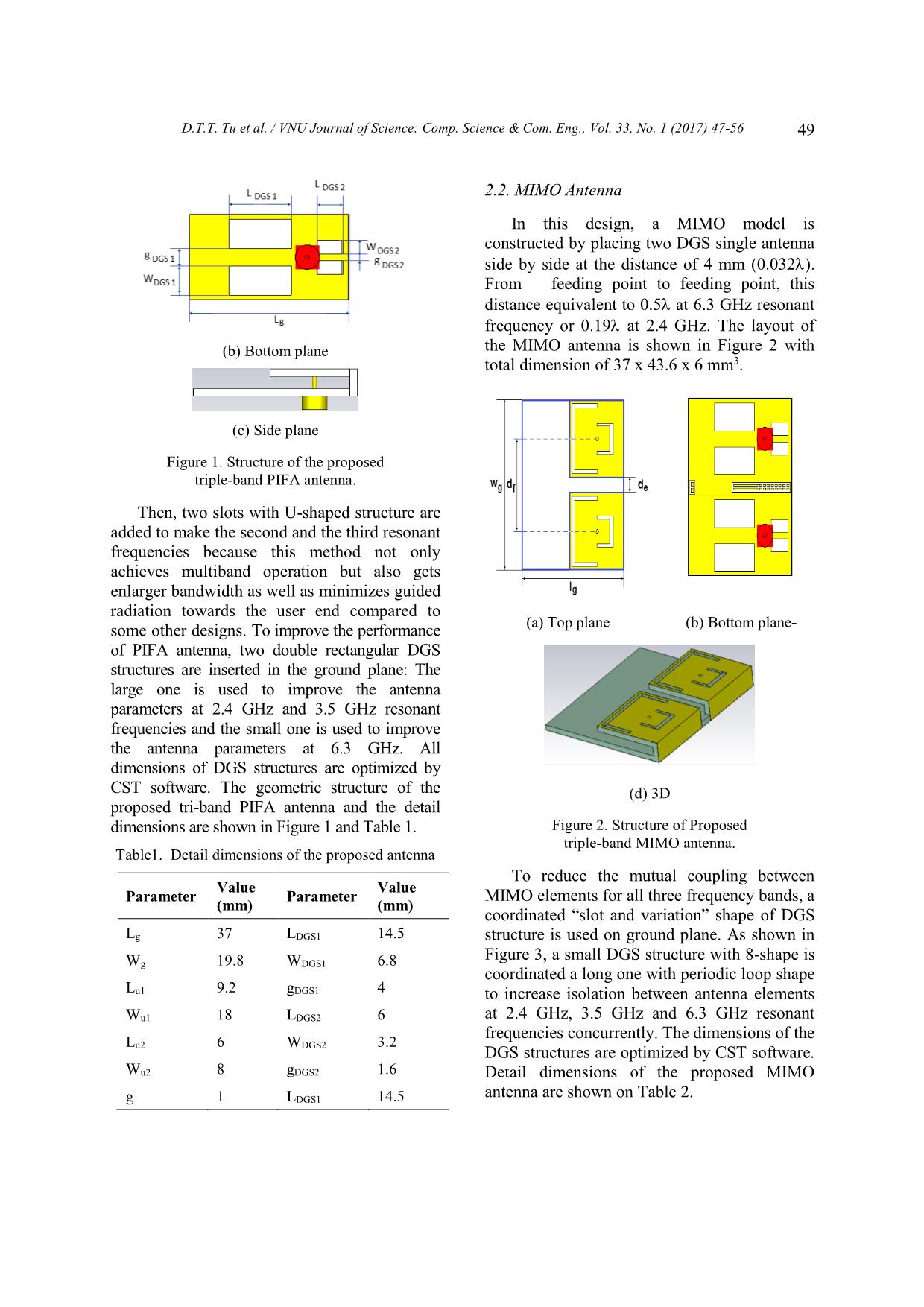
Trang 3
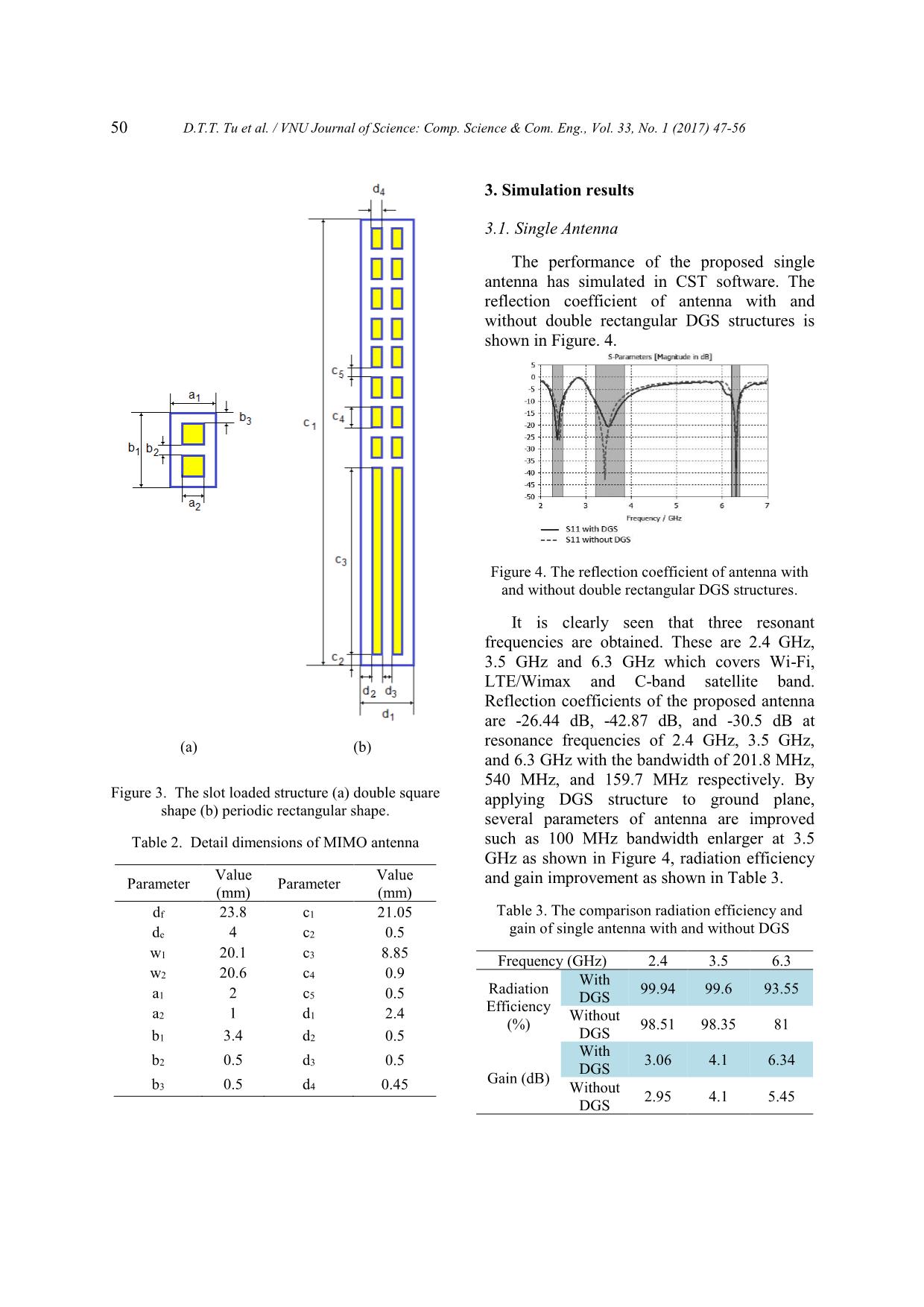
Trang 4
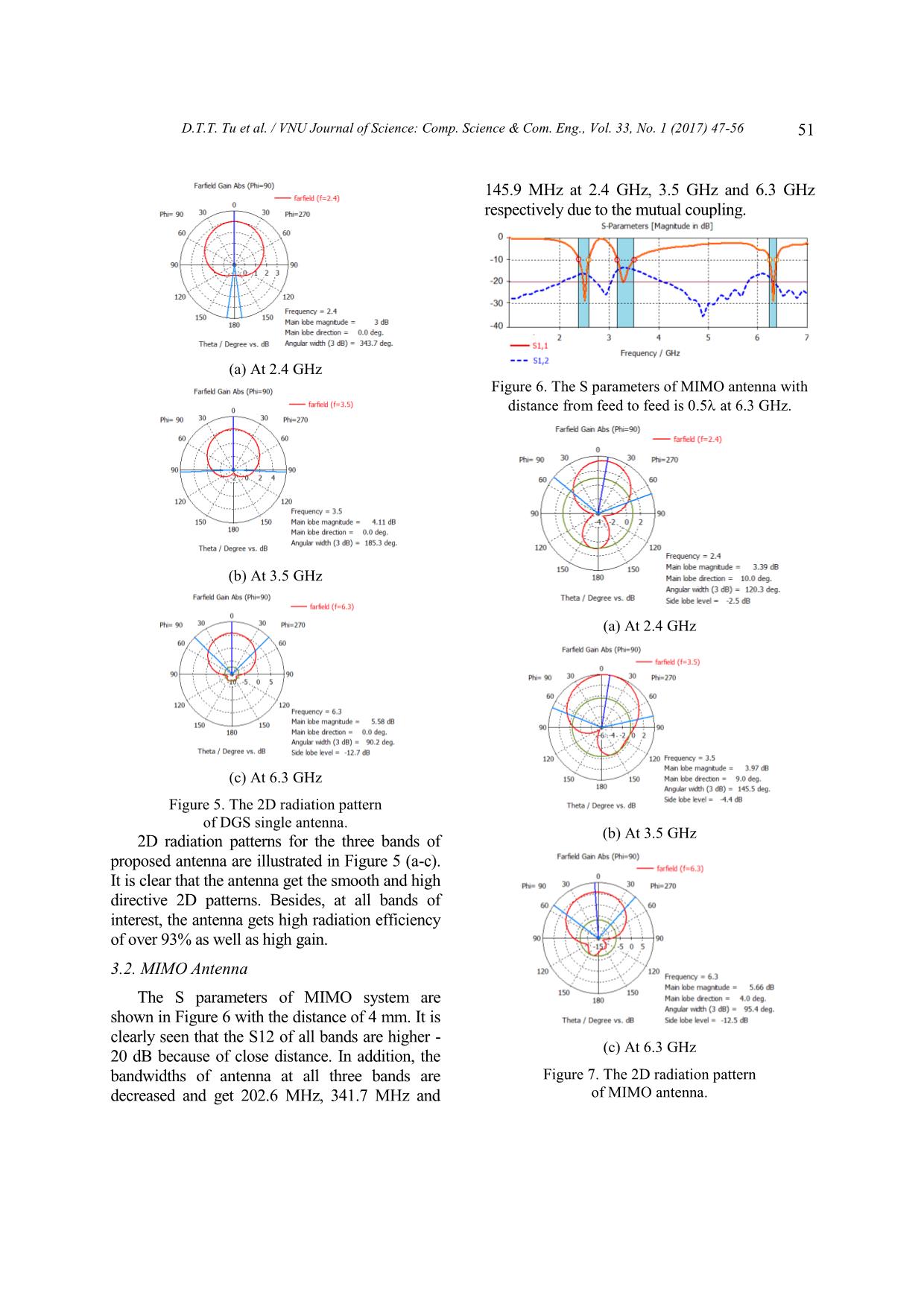
Trang 5
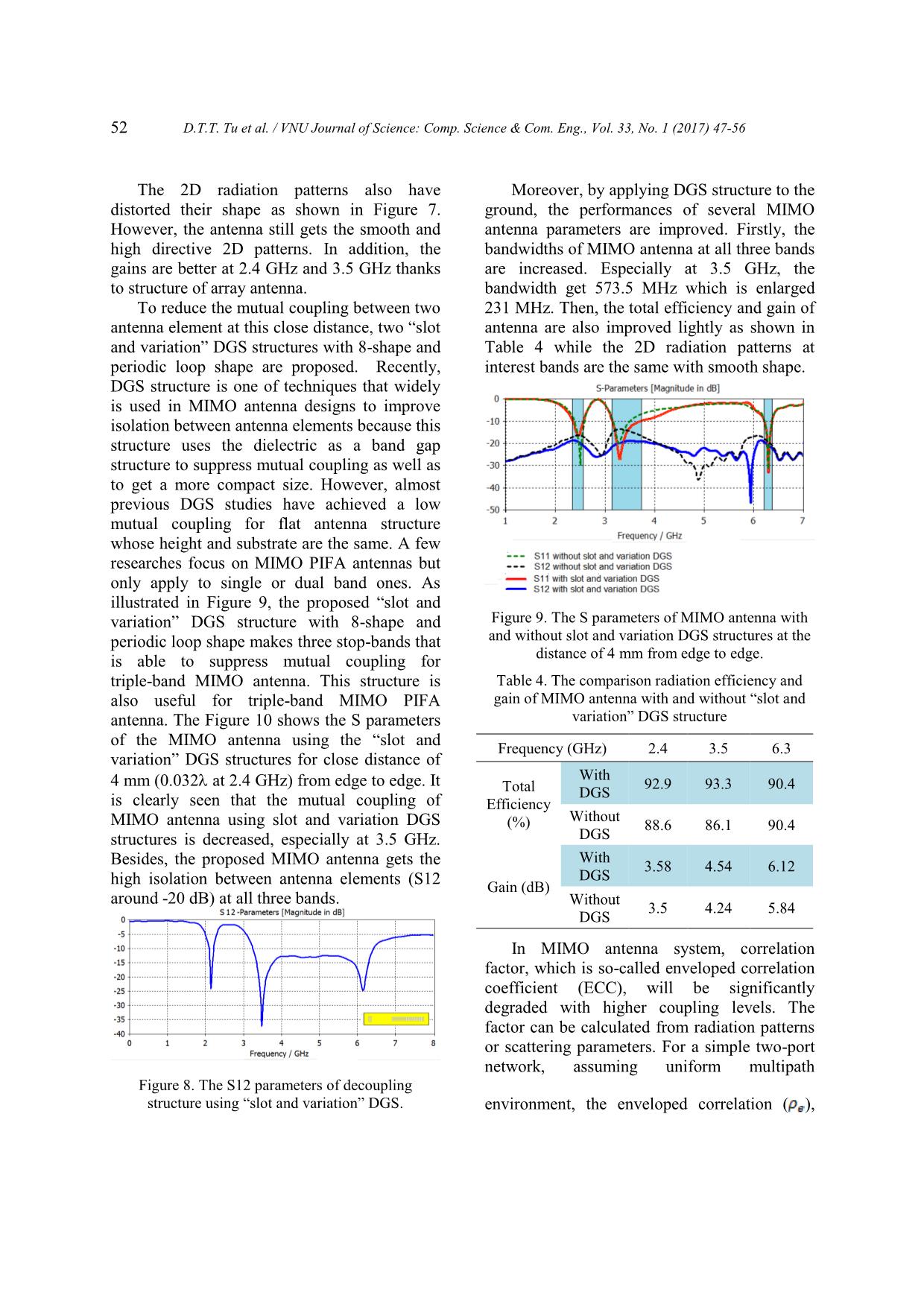
Trang 6
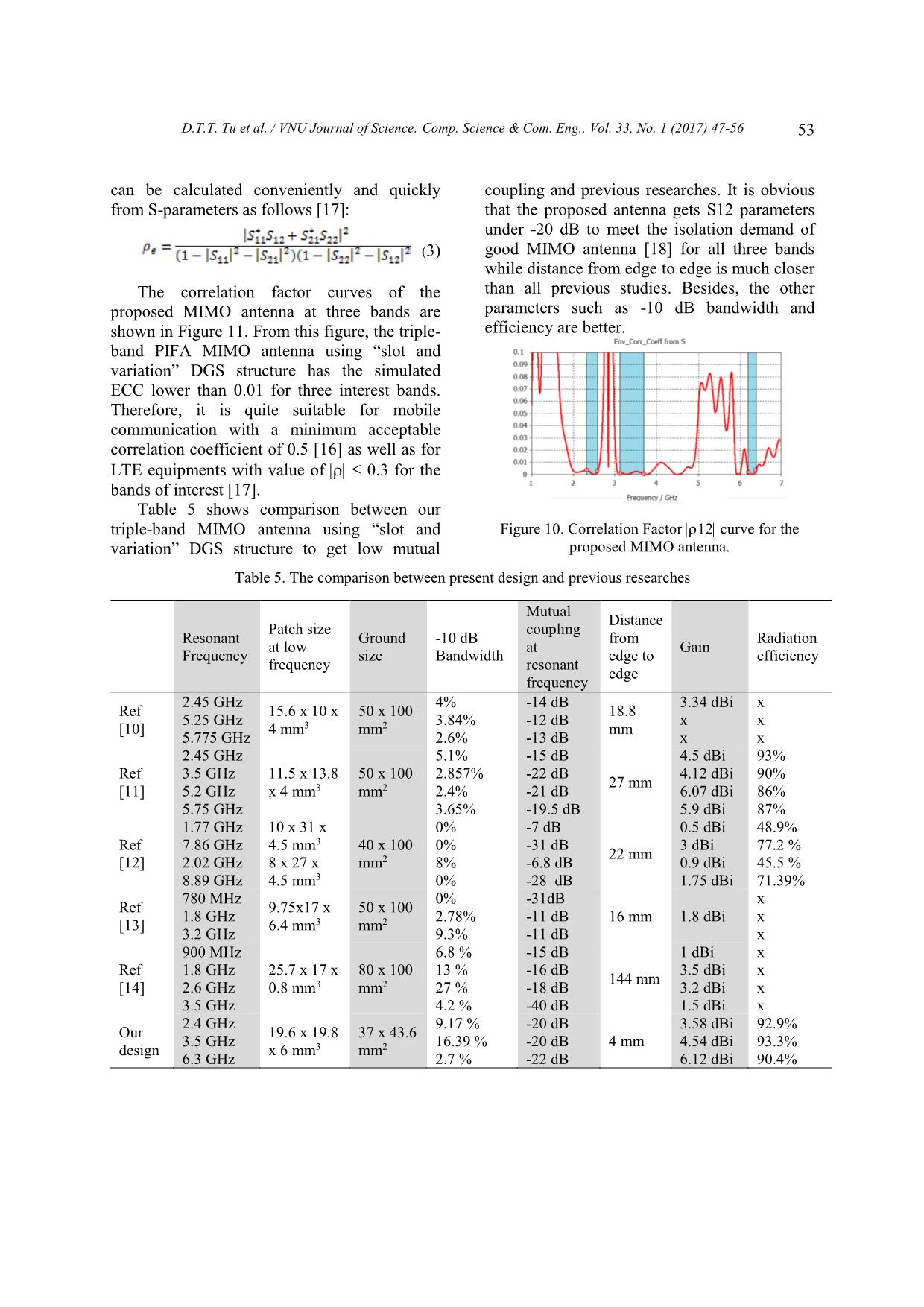
Trang 7
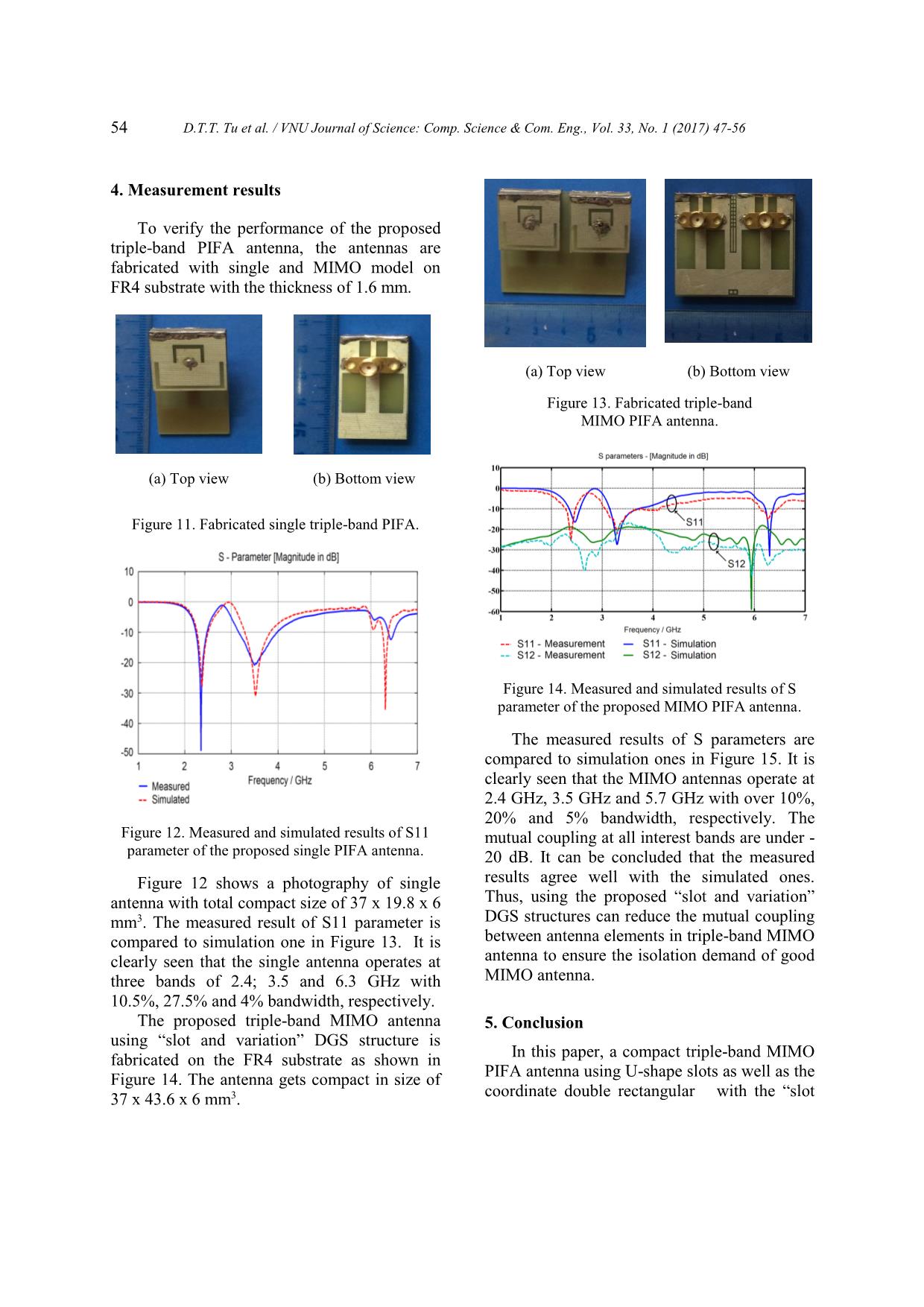
Trang 8

Trang 9
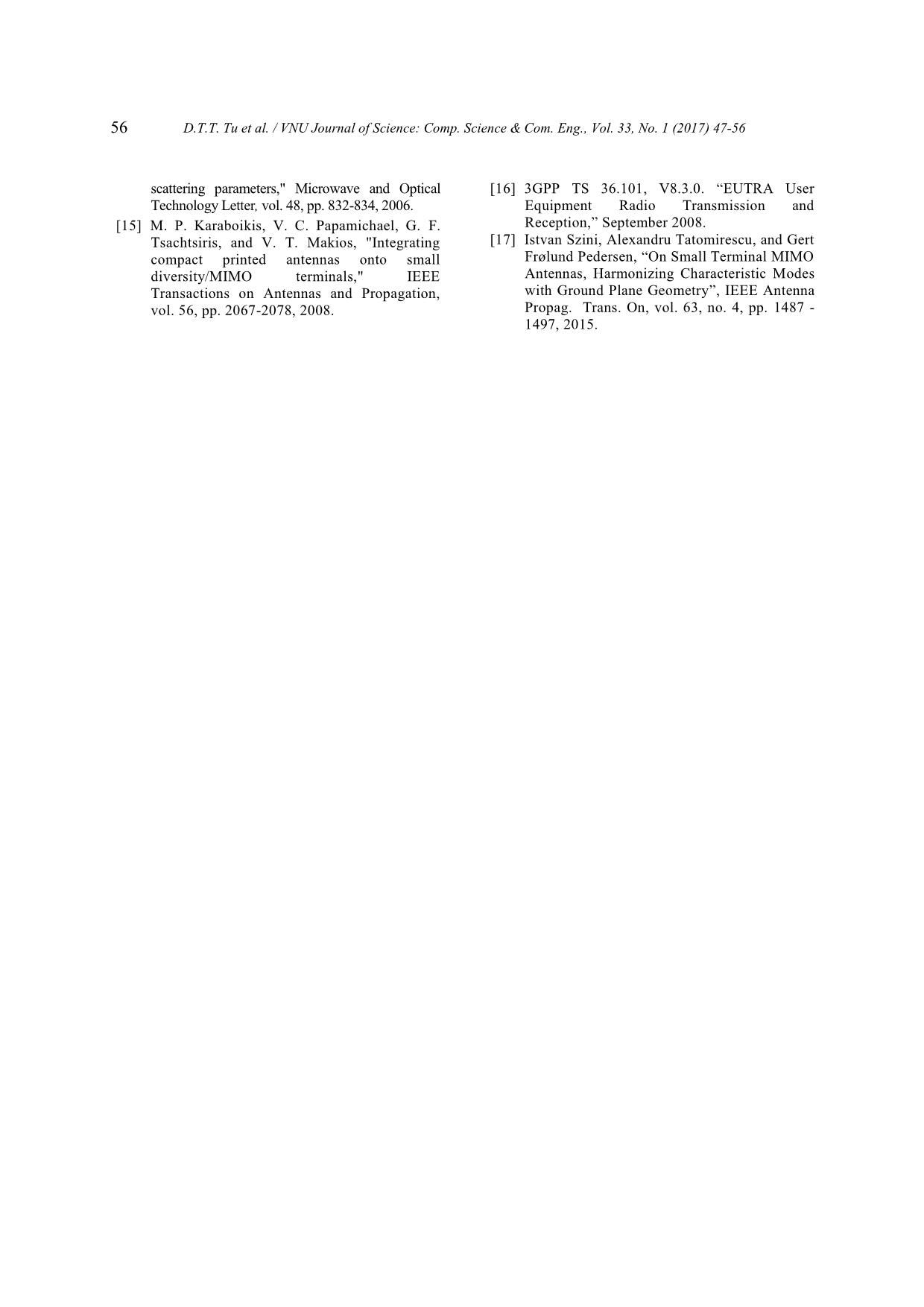
Trang 10
Tóm tắt nội dung tài liệu: Compact triple - Band mimo antenna with high isolation for handheld application

hout double rectangular DGS structures is shown in Figure. 4. Figure 4. The reflection coefficient of antenna with and without double rectangular DGS structures. It is clearly seen that three resonant frequencies are obtained. These are 2.4 GHz, 3.5 GHz and 6.3 GHz which covers Wi-Fi, LTE/Wimax and C-band satellite band. Reflection coefficients of the proposed antenna are -26.44 dB, -42.87 dB, and -30.5 dB at (a) (b) resonance frequencies of 2.4 GHz, 3.5 GHz, and 6.3 GHz with the bandwidth of 201.8 MHz, 540 MHz, and 159.7 MHz respectively. By Figure 3. The slot loaded structure (a) double square applying DGS structure to ground plane, shape (b) periodic rectangular shape. several parameters of antenna are improved Table 2. Detail dimensions of MIMO antenna such as 100 MHz bandwidth enlarger at 3.5 GHz as shown in Figure 4, radiation efficiency Value Value Parameter Parameter and gain improvement as shown in Table 3. (mm) (mm) df 23.8 c1 21.05 Table 3. The comparison radiation efficiency and de 4 c2 0.5 gain of single antenna with and without DGS w1 20.1 c3 8.85 Frequency (GHz) 2.4 3.5 6.3 w2 20.6 c4 0.9 With Radiation 99.94 99.6 93.55 a1 2 c5 0.5 DGS Efficiency a2 1 d1 2.4 Without (%) 98.51 98.35 81 b1 3.4 d2 0.5 DGS With b2 0.5 d3 0.5 3.06 4.1 6.34 DGS Gain (dB) b3 0.5 d4 0.45 Without 2.95 4.1 5.45 DGS D.T.T. Tu et al. / VNU Journal of Science: Comp. Science & Com. Eng., Vol. 33, No. 1 (2017) 47-56 51 145.9 MHz at 2.4 GHz, 3.5 GHz and 6.3 GHz respectively due to the mutual coupling. (a) At 2.4 GHz Figure 6. The S parameters of MIMO antenna with distance from feed to feed is 0.5 at 6.3 GHz. (b) At 3.5 GHz (a) At 2.4 GHz (c) At 6.3 GHz Figure 5. The 2D radiation pattern of DGS single antenna. 2D radiation patterns for the three bands of (b) At 3.5 GHz proposed antenna are illustrated in Figure 5 (a-c). It is clear that the antenna get the smooth and high directive 2D patterns. Besides, at all bands of interest, the antenna gets high radiation efficiency of over 93% as well as high gain. 3.2. MIMO Antenna The S parameters of MIMO system are shown in Figure 6 with the distance of 4 mm. It is clearly seen that the S12 of all bands are higher - (c) At 6.3 GHz 20 dB because of close distance. In addition, the bandwidths of antenna at all three bands are Figure 7. The 2D radiation pattern decreased and get 202.6 MHz, 341.7 MHz and of MIMO antenna. 52 D.T.T. Tu et al. / VNU Journal of Science: Comp. Science & Com. Eng., Vol. 33, No. 1 (2017) 47-56 The 2D radiation patterns also have Moreover, by applying DGS structure to the distorted their shape as shown in Figure 7. ground, the performances of several MIMO However, the antenna still gets the smooth and antenna parameters are improved. Firstly, the high directive 2D patterns. In addition, the bandwidths of MIMO antenna at all three bands gains are better at 2.4 GHz and 3.5 GHz thanks are increased. Especially at 3.5 GHz, the to structure of array antenna. bandwidth get 573.5 MHz which is enlarged To reduce the mutual coupling between two 231 MHz. Then, the total efficiency and gain of antenna element at this close distance, two “slot antenna are also improved lightly as shown in and variation” DGS structures with 8-shape and Table 4 while the 2D radiation patterns at periodic loop shape are proposed. Recently, interest bands are the same with smooth shape. DGS structure is one of techniques that widely is used in MIMO antenna designs to improve isolation between antenna elements because this structure uses the dielectric as a band gap structure to suppress mutual coupling as well as to get a more compact size. However, almost previous DGS studies have achieved a low mutual coupling for flat antenna structure whose height and substrate are the same. A few researches focus on MIMO PIFA antennas but only apply to single or dual band ones. As illustrated in Figure 9, the proposed “slot and variation” DGS structure with 8-shape and Figure 9. The S parameters of MIMO antenna with periodic loop shape makes three stop-bands that and without slot and variation DGS structures at the is able to suppress mutual coupling for distance of 4 mm from edge to edge. triple-band MIMO antenna. This structure is Table 4. The comparison radiation efficiency and also useful for triple-band MIMO PIFA gain of MIMO antenna with and without “slot and antenna. The Figure 10 shows the S parameters variation” DGS structure of the MIMO antenna using the “slot and Frequency (GHz) 2.4 3.5 6.3 variation” DGS structures for close distance of With 4 mm (0.032 at 2.4 GHz) from edge to edge. It 92.9 93.3 90.4 Total DGS is clearly seen that the mutual coupling of Efficiency Without MIMO antenna using slot and variation DGS (%) 88.6 86.1 90.4 structures is decreased, especially at 3.5 GHz. DGS With Besides, the proposed MIMO antenna gets the 3.58 4.54 6.12 DGS high isolation between antenna elements (S12 Gain (dB) around -20 dB) at all three bands. Without 3.5 4.24 5.84 DGS In MIMO antenna system, correlation factor, which is so-called enveloped correlation coefficient (ECC), will be significantly degraded with higher coupling levels. The factor can be calculated from radiation patterns or scattering parameters. For a simple two-port network, assuming uniform multipath Figure 8. The S12 parameters of decoupling structure using “slot and variation” DGS. environment, the enveloped correlation ( ), D.T.T. Tu et al. / VNU Journal of Science: Comp. Science & Com. Eng., Vol. 33, No. 1 (2017) 47-56 53 can be calculated conveniently and quickly coupling and previous researches. It is obvious from S-parameters as follows [17]: that the proposed antenna gets S12 parameters under -20 dB to meet the isolation demand of (3) good MIMO antenna [18] for all three bands while distance from edge to edge is much closer The correlation factor curves of the than all previous studies. Besides, the other proposed MIMO antenna at three bands are parameters such as -10 dB bandwidth and shown in Figure 11. From this figure, the triple- efficiency are better. band PIFA MIMO antenna using “slot and variation” DGS structure has the simulated ECC lower than 0.01 for three interest bands. Therefore, it is quite suitable for mobile communication with a minimum acceptable correlation coefficient of 0.5 [16] as well as for LTE equipments with value of 0.3 for the bands of interest [17]. Table 5 shows comparison between our triple-band MIMO antenna using “slot and Figure 10. Correlation Factor 12 curve for the variation” DGS structure to get low mutual proposed MIMO antenna. Table 5. The comparison between present design and previous researches Mutual Distance Patch size coupling Resonant Ground -10 dB from Radiation at low at Gain Frequency size Bandwidth edge to efficiency frequency resonant edge frequency 2.45 GHz 4% -14 dB 3.34 dBi x Ref 15.6 x 10 x 50 x 100 18.8 5.25 GHz 3.84% -12 dB x x [10] 4 mm3 mm2 mm 5.775 GHz 2.6% -13 dB x x 2.45 GHz 5.1% -15 dB 4.5 dBi 93% Ref 3.5 GHz 11.5 x 13.8 50 x 100 2.857% -22 dB 4.12 dBi 90% 27 mm [11] 5.2 GHz x 4 mm3 mm2 2.4% -21 dB 6.07 dBi 86% 5.75 GHz 3.65% -19.5 dB 5.9 dBi 87% 1.77 GHz 10 x 31 x 0% -7 dB 0.5 dBi 48.9% Ref 7.86 GHz 4.5 mm3 40 x 100 0% -31 dB 3 dBi 77.2 % 22 mm [12] 2.02 GHz 8 x 27 x mm2 8% -6.8 dB 0.9 dBi 45.5 % 8.89 GHz 4.5 mm3 0% -28 dB 1.75 dBi 71.39% 780 MHz 0% -31dB x Ref 9.75x17 x 50 x 100 1.8 GHz 2.78% -11 dB 16 mm 1.8 dBi x [13] 6.4 mm3 mm2 3.2 GHz 9.3% -11 dB x 900 MHz 6.8 % -15 dB 1 dBi x Ref 1.8 GHz 25.7 x 17 x 80 x 100 13 % -16 dB 3.5 dBi x 144 mm [14] 2.6 GHz 0.8 mm3 mm2 27 % -18 dB 3.2 dBi x 3.5 GHz 4.2 % -40 dB 1.5 dBi x 2.4 GHz 9.17 % -20 dB 3.58 dBi 92.9% Our 19.6 x 19.8 37 x 43.6 3.5 GHz 16.39 % -20 dB 4 mm 4.54 dBi 93.3% design x 6 mm3 mm2 6.3 GHz 2.7 % -22 dB 6.12 dBi 90.4% L 54 D.T.T. Tu et al. / VNU Journal of Science: Comp. Science & Com. Eng., Vol. 33, No. 1 (2017) 47-56 4. Measurement results To verify the performance of the proposed triple-band PIFA antenna, the antennas are fabricated with single and MIMO model on FR4 substrate with the thickness of 1.6 mm. (a) Top view (b) Bottom view Figure 13. Fabricated triple-band MIMO PIFA antenna. (a) Top view (b) Bottom view Figure 11. Fabricated single triple-band PIFA. Figure 14. Measured and simulated results of S parameter of the proposed MIMO PIFA antenna. The measured results of S parameters are compared to simulation ones in Figure 15. It is clearly seen that the MIMO antennas operate at 2.4 GHz, 3.5 GHz and 5.7 GHz with over 10%, 20% and 5% bandwidth, respectively. The Figure 12. Measured and simulated results of S11 mutual coupling at all interest bands are under - parameter of the proposed single PIFA antenna. 20 dB. It can be concluded that the measured Figure 12 shows a photography of single results agree well with the simulated ones. antenna with total compact size of 37 x 19.8 x 6 Thus, using the proposed “slot and variation” mm3. The measured result of S11 parameter is DGS structures can reduce the mutual coupling compared to simulation one in Figure 13. It is between antenna elements in triple-band MIMO clearly seen that the single antenna operates at antenna to ensure the isolation demand of good three bands of 2.4; 3.5 and 6.3 GHz with MIMO antenna. 10.5%, 27.5% and 4% bandwidth, respectively. The proposed triple-band MIMO antenna 5. Conclusion using “slot and variation” DGS structure is fabricated on the FR4 substrate as shown in In this paper, a compact triple-band MIMO Figure 14. The antenna gets compact in size of PIFA antenna using U-shape slots as well as the coordinate double rectangular with the “slot 37 x 43.6 x 6 mm3. D.T.T. Tu et al. / VNU Journal of Science: Comp. Science & Com. Eng., Vol. 33, No. 1 (2017) 47-56 55 and variation” DGS structures is proposed. The Progress In Electromagnetics Research C, vol. total MIMO antenna occupies a small area of 37 67, pp. 153–164, 2016. x 43.6 mm2 on the FR4 substrate. The MIMO [5] Mustapha El Halaoui et al., “Dual Band PIFA antenna gets the large bandwidths which are for WLAN and WiMAX MIMO Systems for Mobile Handsets,” 9th International 220 MHz, 573.5 MHz and 170 MHz at 2.4 Conference Interdisciplinarity, Tirgu-Mures, GHz, 3.5 GHz and 6.3 GHz respectively. The Romania, pp. 878-883, October 2015. proposed MIMO PIFA antenna has solved the [6] Do-Gu Kang, Jinpil Tak, and Jaehoon Choi, narrow bandwidth limitation of conventional “MIMO Antenna with High Isolation for PIFA. In addition, using novel DGS structures, WBAN Applications,” International Journal the antenna not only gets the extremely high of Antennas and Propagation, Volume 2015, radiating efficiency of more than 90% for all Article ID 370763, 7 pages, 2015. bands but also gets the high gain of the antenna [7] Ajinkya Vekhande, Ajinkya Joshi, Madhur which is respectively 3.6 dB, 4.55 dB and 5.86 Kapse, Sagar Lohit, Yashashree Bhange, “Dual Band Print Antenna for Wireless dB at 2.4 GHz, 3.5 GHz and 6.3 GHz operating Applications with Enhanced Isolation,” Int. frequency, respectively. Besides, the MIMO Journal of Engineering Research and antenna has ensured the mutual coupling Applications, vol. 5, no. 4, pp. 82-84, 2015. between antenna elements under -20 dB for all [8] Majid Manteghi and Yahya Rahmat-Samii, “A three bands with the narrow distance of 4 mm. Novel Miniaturized Triband PIFA for MIMO This proposed antenna is suitable for handheld Applications,” Micowave and Optical terminals of Wi-Fi, Wimax/LTE and C-band Technology Letters, vol. 49, no. 3, pp. 724- 731, 2007. satellite applications. [9] Rashid Ahmad Bhatti, Jung-Hwan Choi, and Seong-Ook Park, “Quad-Band MIMO Antenna Array for Portable Wireless Acknowledgments Communications Terminals,” IEEE Antenna and Wireless propagation Letters, vol. 8, pp. This work is partly supported by Motorola 129-132, 2009. Solutions Foundation under Motorola [10] K. Zhao , S. Zhang, and & S. L. He, “Closely- scholarship and research funding program for Located MIMO Antennas of Tri-Band for WLAN Mobile Terminal Applications,“ ICT education. Journal of Electromagnetic Waves and Applications, vol. 24, pp. 363–371, 2010. [11] J. Jasper Sweetlin, T. Anita Jones Mary, “Mutual References Decoupling in Quad Band MIMO Slotted PIFA for Wireless Applications,” The International Journal [1] Hang Wong, Kwai-Man Luk, Chi Hou Chan, of Engineering and Science (IJES), vol. 1, no. 2, Quan Xue, Kwok Kan So, Hau Wah Lai, “Small pp. 303-307, 2012. antennas in Wireless Communications,” [12] Jianfeng Zhu, Botao Feng, Li Deng, Biao Proceedings of the IEEE Journal, vol. 100, no 7, Peng, and Shufang Li, “Coupled-Fed Tri-Band pp. 2109-2121, 2012. MIMO Antenna for WWAN and LTE [2] Rowell, C., Lam, E.Y., “Mobile phone antenna Application,” Microwave and Optical design,” IEEE Antennas and Propagation Technology Letters, vol. 59, no. 2, pp. 463- Magazine, vol. 54, no. 4, pp. 14-34, 2012. 468, February 2017. [3] Murch, R.D., and Letaief, K.B., “Antenna systems [13] Duong Thi Thanh Tu, Nguyen Gia Thang, Vu for broadband wireless access,” IEEE Van Yem, “A Triple-band PIFA Antenna Communication Magazine, vol. 40, pp. 76-83, Design Using Defected Ground Structure for 2002. Handheld Applications”. International Conference on Science and Technology, [4] Ahmed A. Naser, Khalil H. Sayidmarie, and pp.745-750, Nov 2016. Jabir S. Aziz, “Compact High Isolation Meandered-Line PIFA Antenna for LTE [14] J. Thaysen and K. B. Jakobsen, "Envelope (Band-Class-13) Handset Applications,” correlation in (N, N) MIMO antenna array from 56 D.T.T. Tu et al. / VNU Journal of Science: Comp. Science & Com. Eng., Vol. 33, No. 1 (2017) 47-56 scattering parameters," Microwave and Optical [16] 3GPP TS 36.101, V8.3.0. “EUTRA User Technology Letter, vol. 48, pp. 832-834, 2006. Equipment Radio Transmission and [15] M. P. Karaboikis, V. C. Papamichael, G. F. Reception,” September 2008. Tsachtsiris, and V. T. Makios, "Integrating [17] Istvan Szini, Alexandru Tatomirescu, and Gert compact printed antennas onto small Frølund Pedersen, “On Small Terminal MIMO diversity/MIMO terminals," IEEE Antennas, Harmonizing Characteristic Modes Transactions on Antennas and Propagation, with Ground Plane Geometry”, IEEE Antenna vol. 56, pp. 2067-2078, 2008. Propag. Trans. On, vol. 63, no. 4, pp. 1487 - 1497, 2015. p
File đính kèm:
 compact_triple_band_mimo_antenna_with_high_isolation_for_han.pdf
compact_triple_band_mimo_antenna_with_high_isolation_for_han.pdf

